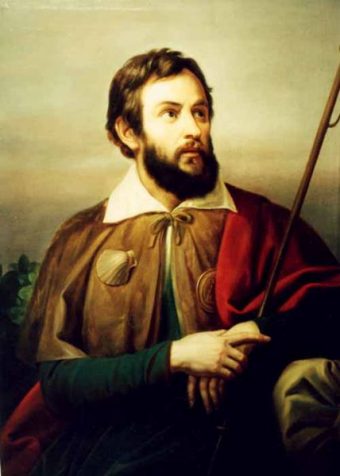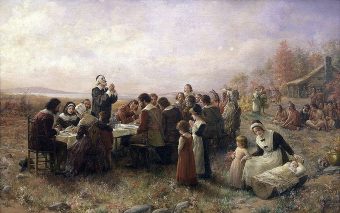The Many Myths Surrounding the Pilgrims and Thanksgiving
 Myth: Pilgrims wore black and white clothing with buckled top hats.
Myth: Pilgrims wore black and white clothing with buckled top hats.
The myth that they dressed like this stems from a popular clothing style in England in the late 17th century, which carried over to 18th and 19th century artist depictions of Pilgrims. In fact, historical records of Pilgrims’ clothing, such as the passenger list of the Mayflower, wills, which included descriptions of clothing, and other such records, paint a very different picture than the late 17th century artists depicted. For starters, the Pilgrims didn’t wear buckled hats. They also didn’t wear buckles on their shoes or waists. Buckles were expensive and not in fashion at the time. They simply wore the much cheaper leather laces to tie up their shoes and hold up their pants. Buckles later became very popular in England for their expense and as a fashion statement. Those who were too poor to afford buckles wore laces, similar to the Pilgrims.
They also didn’t only wear black and white. The Pilgrim’s common garb was very colorful, as was the fashion at the time. They only wore predominately black and gray clothing on Sundays. The rest of the time, they wore heavily dyed clothing in many different colors. For one example, a Pilgrim by the name of Brewster left his clothing in his will to someone, which was described as such: “one blew clothe suit, green drawers, a vilolete clothe coat, black silk stockings, skyblew garters, red grograin suit, red waistcoat, tawny colored suit with silver buttons.”
Another myth surrounding the Pilgrims is that they would have probably died the first winter had the Native Americans not taught them various agricultural tips and tricks. In fact, the Pilgrims didn’t come so unprepared. They had a contract with various merchants who would come regularly to bring them supplies of food, clothing, etc for a term no less than seven years, while they established their colony. They were also well versed in hunting and farming techniques from Europe. When the Pilgrims left, they were quite well aware of the colonies that had tried to settle in America and failed; thus, they took appropriate steps to avoid that happening to them.
 This all brings us to the most pervasive myth of all concerning the Pilgrims, that they celebrated the first Thanksgiving in America and invited the Native Americans to join in.
This all brings us to the most pervasive myth of all concerning the Pilgrims, that they celebrated the first Thanksgiving in America and invited the Native Americans to join in.
The Pilgrims did not celebrate the first Thanksgiving in America. In fact, the particular Pilgrim event that is often cited as the first Thanksgiving wasn’t even the Pilgrim’s first Thanksgiving. They had several before then at various times and none of them were an annual thing. These days were simply a particular time where they had something significant to thank God about, so would set aside a day to do so.
Around the time the Pilgrims came to America in 1620, it was common in England and many parts of Europe to frequently set aside days for giving thanks to God. In the New World, where life was harsh in the beginning, there were numerous opportunities to hold such days of thanks, for example: any time a particularly good crop would come in; anytime a drought would end; anytime a particularly harsh winter was survived; anytime a group managed to repel an attack by Native Americans; anytime a supply ship arrived safely from Europe; etc. This sort of practice remained fairly common up until around the time when Thanksgiving became a national holiday. Most of these celebrations bore little resemblance to what we think of as Thanksgiving. Indeed, even the particular Thanksgiving day that the Pilgrims celebrated sometime between September and early October of 1621 bore little resemblance to what is depicted now.
So who actually celebrated the first Thanksgiving in America? Nobody knows for sure owing to how common these days of thanks were in the New World. Three popular examples that are often referenced as the actual “firsts” and that pre-date the Pilgrims date include:
- September 8, 1565: This day of thanksgiving was celebrated by a group of Spaniards lead by Spanish explorer Pedro Menéndez de Avilé, in Saint Augustine, Florida. Interestingly, Menéndez de Avilé even invited the Timucua tribe to dine with them on that Thanksgiving.
- 1598: In San Elizario, Texas, Spanish explorer Juan de Onate, on the banks of the Rio Grande, along with those with him held a Thanksgiving festival after they successfully crossed over 350 miles of Mexican desert.
- December 4, 1619: Thirty-eight settlers landed on James River, on a ship called the Margaret, about 20 miles from Jamestown. Their charter required that the day of landing be set aside as a day of thanksgiving both on that first date and every year after. This tradition died out due to the “Indian Massacre of 1622″ where many of the settlers were killed and most of the rest fled to Jamestown.
OK, so they weren’t the first, but they invited the Native Americans to their 1621 party right? In truth, from the only two first-hand passages that directly describe the event in question, a letter from Edward Winslow in December of 1621 and William Bradford’s passage in “Of Plymouth Plantation,” it would appear the party was held with no such invite. We do know the Native Americans stopped by at random times, probably attracted by all the noisy games like shooting contests, and some that stopped by were allowed to participate, but as for specifically thinking to invite them to take part in the event, there’s no such record nor any real indication of this.
So why is the Pilgrim Thanksgiving that happened in the autumn of 1621 often considered the first Thanksgiving and why do we have all these myths surrounding the 1621 event? This is largely thanks to Sarah Josepha Hale, author of the nursery rhyme “Mary Had a Little Lamb” and one of the most influential women in American history.
She was particularly enamored with this Pilgrim event that she had read about in a passage by William Bradford in Of Plymouth Plantation as well as the particular Thanksgiving tradition which was somewhat common in New England at the time. She tirelessly campaigned for over 20 years to have Thanksgiving become a national holiday with a set date and was ultimately successful.
Through her highly circulated editorials, she was largely responsible for much of why we view the Pilgrim’s 1621 Thanksgiving how we do and was also largely responsible for many of the traditions we now tend to attribute to that Thanksgiving. For example, things like the tradition of eating turkey, mashed potatoes, stuffing, cranberry sauce, and pumpkin pie on Thanksgiving were all popularized by her and it is extremely unlikely that the Pilgrims ate any of those things.
If you liked this article, you might also enjoy our new popular podcast, The BrainFood Show (iTunes, Spotify, Google Play Music, Feed), as well as:
- The Remarkable Sara Hale and the Fascinating Story Behind How Thanksgiving Became a National Holiday in the United States
- Why Turkeys Are Called Turkeys
- Does Turkey Actually Make You Drowsy After You Eat It?
- Why the Day After Thanksgiving is Called “Black Friday”
- How the Tradition of the Detroit Lions Playing on Thanksgiving Got Started
Bonus Facts:
- The first record of the term “pilgrim” applying to the Mayflower passengers, and those of their group that followed later, appeared in William Bradford’s Of Plymouth Plantation. In it, he used biblical imagery to describe the Pilgrim’s departure from Leiden in 1620: “So they lefte goodly & pleasante citie, which had been ther resting place, here 12 years; but they knew they were pilgrimes, & looked not much on these things; but lift up their eyes to ye heavens, their dearest cuntrie, and quieted their spirits.” The next two instances of them being called Pilgrims came when Nathaniel Morton and Cotton Mather in 1669 and 1702, respectively, both paraphrased Bradford’s words. The next reference was in 1793 by Rev. Chandler Robbins who recited Bradford’s words at a Plymouth Forefathers’ Day observance. From here, the term caught on and it became popular to toast to the “Pilgrims of Leyden” on this observance day. By 1820, Daniel Webster referred to this group as the “Pilgrims” at the Plymouth’s bicentennial, which is hugely responsible for the term being picked up popularly as the name of this group.
- Yet another myth surrounding the Pilgrims and Thanksgiving is that they were taught by the Indians to make Popcorn and served it at the “first” Thanksgiving. In fact, while there is little evidence of what they actually ate at their first Thanksgiving, it is very unlikely that they ate popcorn, due to the fact that all they had available was flint corn, at the time. This type of corn doesn’t pop when heated, rather just expands slightly. Thus, it wasn’t very palatable in this form, so they tended to boil it, preparing it as hominy.
| Share the Knowledge! |
|





Great article and thanks for posting the myth, in regards to the type of clothing worn by the 1620, Plymouth Colony Pilgrims, and that they didn’t wear buckles on their shoes and hats. I had thought that the buckles were attributed to style of clothing worn by the Puritans that arrived in Massachusetts in 1628 – was actually the style of clothing worn in England, at that time. William Bradford, mentioned in the article, is my tenth great-grandfather. I also enjoyed your article “The Remarkable Sara Hale and the Fascinating Story Behind How Thanksgiving Became a National Holiday in the United States.” She was truly a remarkable woman!
C’mon folks…the least you can do, by refusing to publish a reasonably fair comment, is to at least tell me why that previous comment is not being published…obviously you read these comments before they go public…so c’mon…talk to me…let’s hear what was so wrong with my post. Thanks…
More leftist lies.
Polk14….good grief…just do the research yourself.
I wouldn’t rate it as a “myth” since the starving-pilgrims-saved-by-Indians story was the official, state-sanctioned Truth sanctioned during my entire time in public school, and specificially taught in my second grade American History class.
Perhaps the word you’re looking for is “propaganda” or “fraud.”
If anything, “Thanksgiving” was less ridiculous than the story of Petit Jean that we were taught, again from state-authorized textbooks, some years later.
myth
miTH/Submit
noun
1.
a traditional story, especially one concerning the early history of a people or explaining some natural or social phenomenon, and typically involving supernatural beings or events.
synonyms: folk tale, folk story, legend, tale, story, fable, saga, mythos, lore, folklore, mythology
“ancient Greek myths”
2.
a widely held but false belief or idea.
“he wants to dispel the myth that sea kayaking is too risky or too strenuous”
Yeah, using the word “myth” sums it up well enough.
Wampanoag descendants say they were “attracted” to the noisy gunfire to see if it signaled a threat to their nation.
According to National Geographic, the Pilgrims arrived much further north than they intended, and were not accustomed to the harsher climate, therefore might indeed have died without the help of the natives.
Sir Martin Frobisher and his crew are credited as the first Europeans to celebrate a Thanksgiving ceremony in North America, in 1578.